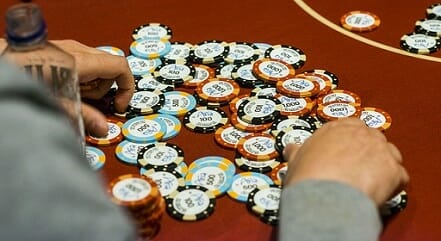How Much to Buy In for When Playing $1/2 or $1/3No-Limit Texas Hold’em, & What is the Minimum?
$1/2 No-limit hold’em and $1/3 No-Limit hold’em are the most commonly spread game found in North American poker rooms.
While Stud and limit hold’em games used to dominate the card room scene, the popularity of the World Series of Poker broadcasts on ESPN starting in 2003, (along with the World Poker Tour broadcasts), transformed the poker landscape. Recreational players wandering into a poker room wanted to play no-limit, and thus, the game has become the dominant force in nearly every card room today.

The standard, initial buy-in for a typical $1/2 No-Limit game of Texas Hold’em poker is $200. For $1/3 No-limit, many players buy-in for $300.
Although not required, the standard buy-in for any no-limit game is 100x the big blind. So in our $1/2 example, the big blind is $2, hence the $200 buy-in.
As for the minimum buy-in? It varies from casino to casino, however usually the minimum will be $40 or $60. At the Venetian Poker Room in Las Vegas, the minimum buy-in is $100.
Buy-In for Playing $1/2 No-Limit Texas Hold’em
As we’ve mentioned, the rule of thumb with regards to buy-ins, is 100x the big blind. More and more poker rooms are going to a $1/3 structure, meaning in this case, you’d want to sit down with $300 on the table. Similarly, if you have the guts to jump into a $2/5 no limit game, be sure to have $500 on the table.
This article isn’t a treatise on the merits of short stack play, however while the low $40 buy-in is tempting, you should never buy into a no-limit game for the bare minimum.
Having a full stack at the table, (in this case, starting off with $200 at $1/2), allows you to extract the most amount of money possible with your good hands. In a rare (but fun) example, let’s say you sit down at the felt, and on your first hand, you flop a straight flush. Let’s also say another player (with a normal stack) has flopped the weaker, Ace-high flush, and is confident he is going to win the hand, (which is not an unreasonable thought by the way).

In this admittedly extreme example, there’s likely to be an “All-in” and a call. You have the straight flush. Did you buy-in for $200? Good, because that means you’ve just won $200. But the nervous guy playing with scared money who bought in for the minimum of $40 is going to see this incredible hand win just $40.
You’ve just won an extra $160 by buying in for the correct amount. And at these lower limits with amateur players, you’ll occasionally see two (or even more) players going all-in. Trust me when I say the when you push a full stack into the middle, holding the nuts, it’s incredibly exciting to see two other players holding equally sized stacks call your “all-in.” Pushing just $40 into the middle would result in your back being sore for kicking yourself all night for not buying in for a proper amount.
Some of you are undoubtedly thinking of the worst case scenario, when say, you’ve flopped a full house, push all-in, then get a caller who has, say trips, but who ends up making quads on the river. In this case you would have only lost your weak, $40 buy-in. But is that a victory?
This is poker. Bet your money, play your hand and literally let the chips fall where they may. A player not bold enough, or confident enough in his or her play to risk a normal stack on one hand should avoid the poker room and seek comfort among the masses in the penny slot area.
Besides maximizing your profit potential, another reason to buy in for 100x the big blind is that an average to large stack will act as a line of defense in protecting your stack.
In a situation where the betting is down to just you and one other opponent (called a “heads-up” situation), an aggressive player is much less likely to go all-in on you when he or she sees that you have a healthy stack.
Alternatively, a normal to large stack helps you pick up chips, as the chip stack acts as heavy artillery against potential callers. If you are on a bluff, or a decent hand that could easily get beaten by the river, an all-in bet with $180 is much more intimidating that an all-in with $30. When holding just $30 or $40, there’s much less risk for your opponent, and hence, much more incentive for that player to call to either see if you have it.
Bankroll for $1/2 No-Limit Texas Hold’em
In terms of a session, many poker and bankroll theorists suggest you fire only three bullets maximum. In other words, bring only three buy-ins with you to the game. In this case, $600 maximum. (The more conservative players suggest you only buy-in twice a night, or $400 maximum).
Should those three bullets get spent, resist the urge to hit up the ATM machine, or ask a buddy for a loan. Losing three buy-ins means it wasn’t your night. If you do reload, you may not play your best, as you’ll be either steaming, on tilt, or just looking to catch back up, and therefore not playing your best game. So after losing three buy-ins, just call it quits and live to fight another day. So for a two day trip to Las Vegas, playing just $1/2 no-limit, you should have at least $1,200 in your roll.
In terms of long-term bankroll, many pros have suggested that because living expenses will need to be addressed in the daily win and loss calculations, a 50 buy-in bankroll is needed to ride out the swings of variance.
So in our $1/2 no-limit example, a professional wanting to play those stakes (and that wouldn’t be much of a life), would need to start off with a $10,000 bankroll.
Lastly, we talked about minimum buy-ins earlier. But in addition to the minimum buy-ins, most poker rooms have a maximum buy-in as well. In a typical $1/2 no-limit game, the maximum will be $200 or $300.
(By Steve Beauregard. Photos courtesy of World Poker Tour via Flickr).
